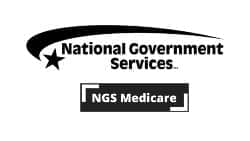
In addition, NGS Medicare handles Medicare home health and hospice contracts in Alaska, Arizona, California, Connecticut, Hawaii, Idaho, Maine, Massachusetts, Michigan, Minnesota, Nevada, New Hampshire, New Jersey, New York, Oregon, Rhode Island, Vermont, Washington, Wisconsin, and all U.S. states and territories except American Samoa, Guam, Northern Mariana Islands, Puerto Rico, and the Virgin Islands.
NGS Medicare manages Medicare Part B – medical insurance – contracts for Connecticut, Illinois, Maine, Massachusetts, Minnesota, New Hampshire, New York, Rhode Island, Vermont, and Wisconsin.
Official Login
or
Get Assistance
Registration Process At NGS Medicare
Here are the steps you need to follow to register with NGS medicare.com’s official login page:
- Visit the official website of NGS Medicare at: https://www.ngsmedicare.com/.
- Click on “Enrollment” in the top menu bar of NGS Medicare.
- An authorization and accreditation process is the first step.
- Once you have determined the application fee, pay it.
- An enrollment application must be submitted in the third step of the NGS Medicare portal.
- The fourth step involves the electronic transfer of funds.
- The fifth step consists in offering all of the above information.
- Additionally, you must provide a valid, current email address to NGS Medicare.
- EDI registration is the last step. Click here to register.
Upon completing the whole process, you will receive a confirmation email from the official login portal of NGS Medicare along with your login credentials, including your I.D. and Password.
NGSMedicare.com Login Process
To use the benefits and services offered on the NGS Medicare after completing the registration process, you must follow the following steps:
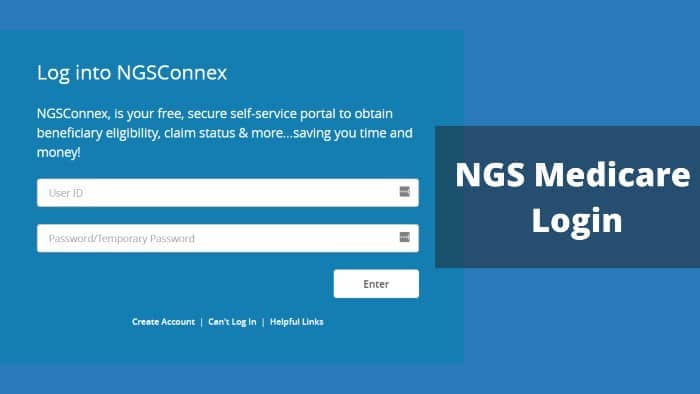
- Visit the official website of NGS Medicare at: https://www.ngsmedicare.com/. by visiting the excellent browser.
- Click on the Login link to access the login page.
- Your browser will redirect you to a new page.
- Please enter the login name and password you created while registering at the website.
- In the end, you click on the submit button.
About www.ngsmedicare.com
Federal health agencies, such as the CMS, have relied on NGS Medicare, Inc. for years. NGS Medicare has established a national leadership position in NGS Medicare with its efficient operations, financial resources, and human resources for the past 55 years.
Fee Schedules
The Balanced Budget Act of 1997 mandated the implementation of a national fee schedule for ambulance services furnished under Medicare of NGS Medicare Part B. The fee schedule is in effect for claims with a service date after April 1, 2002. The law applies to all ambulance services, including volunteer, municipal, private, independent, and institutional ones, including hospitals, critical access hospitals (except when there is no ambulance service within 35 miles), and skilled nursing facilities.
Clinical Laboratory Fee Schedule
- The “Protecting Medicare and American Farmers from Sequester Cuts Act” (S. 610) was passed on December 10, 2021, and delayed the reporting requirement under Section 1834A of the Act. In addition, they waited for the phase-in of the 15% reduction.
- According to Section 216(a) of the Protecting Access to Medicare Act of 2014 (PAMA), Section 1834A of the Act requires significant changes to the way Medicare pays for Clinical Diagnostic Laboratory Tests (CDLTs) under the CLFS. On June 23, 2016, the CMS-1621-F “Medicare Clinical Diagnostic Laboratory Tests Payment System Final Rule” (CLFS-1621-F) was published in the Federal Register. Essentially, the CLFS enforces section 1834A. The CLFS final rule requires reporting entities to provide CMS with certain private payer rate information (applicable information) for their component appropriate laboratories. This data collection period (the period when relevant information about a suitable laboratory is obtained from claims for which the laboratory received final payment) occurred from January 1, 2019, through June 30, 2019.
| Official Name | NGS medicare |
|---|---|
| Country | USA |
| Company | Anthem |
| Language | English |
| Purpose | Medical Tools |
Medical Equipment Fee Schedule
The Consolidated Appropriations Act of 2021 (Public Law 116-260) was signed into law on December 27, 2020. Effective April 1, 2021, section 121 of this Act eliminates the budget neutrality requirement outlined in section 1834(a)(9)(D)(ii) of the Act for separate classes and national limited monthly payment rates established for any item of oxygen and oxygen equipment using the authority in section 1834(a)(9)(D)(i) of the Act. Effective for claims with dates of service on or after April 1, 2021, the fee schedule amounts for HCPCS codes E0424, E0431, E0433, E0434, E0439, E0441, E0442, E0443, E0444, E0447, E1390, E1391, E1392, E1405, E1406, and K0738 are adjusted to remove a percentage reduction necessary to meet the budget neutrality requirement previously mandated by section 1834(a)(9)(D)(ii) of the Act.
These adjustments increase fee schedule amounts ranging from $6.72 to $8.19 in former competitive bidding areas, $5.17 to $5.43 in other non-rural areas, and $4.41 to $6.82 in noncontiguous and rural areas.
Billing & Payment
In the revised regulation text, CMS now allows audio-only telephone calls for the therapy and counseling portions of the weekly bundles and for the add-on code for additional counseling or therapy for beneficiaries with opioid use disorders (HCPCS code G2080), provided all other requirements are met. Providers may conduct periodic patient assessments (HCPCS code G2077) via two-way interactive audio-video communication technology or by telephone only in cases when the beneficiary does not have access to two-way interactive technology.
Physician Fee Schedule
In December 2018, CMS published the C.Y. 2022 Medicare Physician Fee Schedule (PFS) final rule, which updated payment policies, payment rates, and other provisions. An overview of key requirements for January 1, 2022, and beyond is below:
- Consolidated Appropriations Act, 2021 revises telehealth services; permits the use of audio-only communications technology when providing mental health services in certain circumstances.
- Implements recent changes to Evaluation and Management (E/M) visit codes, such as policies for split (or shared) visits, critical care services, and teaching physician services.
- The payment for therapy services provided in whole or in part by a Physical Therapist Assistant or an Occupational Therapy Assistant is modified.
- The payment regulation for Medical Nutrition Therapy is updated.
- Considerations for vaccine administration are finalized.
NGS Medicare Connex
The NGS Medicare Connex is a free and secure web application designed especially for the people. NGSConnex of NGS Medicare provides users with self-service functionality that saves time and money for them.
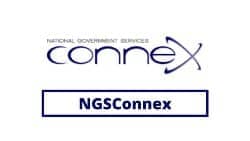
Benefits of NGSConnex
- One can obtain beneficiary eligibility information at NGS Medicare.
- You can query for the status of your claims.
- One can initiate and check the status of redetermination and reopening requests.
- You can view your provider’s demographic information.
- One can query for their financial data.
- You can submit documents for an Additional Documentation Request.
- You can submit Credit Balance Reports.
Why Use?
NGS Medicare Connex of NGS Medicare completes thousands of eligibility-related inquiries and other Medicare transactions every day. If you become a registered user, you will receive instant access to detailed Medicare claim information and be able to perform secure Medicare transactions, saving you time and money!
It is no longer necessary to tie up your phone line, as NGSConnex offers the same eligibility and claim status information you formerly could only obtain via the IVR system. If you are unsuccessful in getting the MBI from the Medicare Beneficiary, you can use the MBI Lookup tool available only from NGS Medicare Connex.
NGSConnex also lets you save and print information for your records on NGS Medicare. For example, providers usually follow a standard intake process to verify Medicare beneficiary eligibility. If you want, you can print the eligibility information or manually enter the data into your records by placing it into NGSConnex, or you can electronically record the data.
Utilizing it allows you to save time and money when responding to Medical Review Additional Documentation Requests. It does not matter if postage is lost in the mail, your reply doesn’t arrive in time, or gets lost in the mail. It’s simple to upload your documents and submit them. When you use it to respond to ADRs, you can also generate an electronic record of the documentation presented and when the response was sent.
Email Verification
NGSConnex will display the Email Verification screen when you log in for the first time. The email associated with it’s user profiles is required to be validated. All NGSConnex users are required to complete this one-time verification.
NGS Connex Login Guidelines.
- Read the standard disclaimer and click I Agree to continue at the NGS Connex Login portal.
- Click the New User Link on the User Login screen.
- Read the Online Services & Web Confidentiality Agreements and click on the check box at the end that reads, “I have read and understood the above statements.” then click I Agree to continue.
- Complete the required fields on the Account, Individual, and Business information screens in the Personal Information panel to get yourself registered at the NGS Connex Login login portal.
You can receive your User ID or Password via NGSConnex if you have forgotten either. On the login screen, select the Forgot User ID or Forgot Password.
Contact Info for NGSConnex Login
Please call 866-837-0241 to connect with NGS Medicare customer care.
NGSConnex Portal access, administration, or site performance assistance can be arranged with Option 2.
Operation hours:
Weekdays-Fridays
From 8:00 am to 4:00 pm Central Time
Every 2nd and 4th Friday of the month, we are closed for training
12 pm-4 pm Eastern Time
Medical Policies
Autonomic Function Testing
It regulates physiological processes, including blood pressure, heart rate, body temperature, digestion, metabolism, fluid balance, electrolyte balance, sweating, urination, defecation, and sexual response. Regulation happens without conscious awareness, i.e., autonomously. ANS has two main parts: sympathetic and parasympathetic. Electrocardiogram (ECG) R-R interval changes due to parasympathetic or sympathetic stimulation are measured in ANS testing. In such a test, signs and symptoms of possible autonomic dysfunction are correlated with an objective measurement in a clinically useful way. Some organs are primarily regulated by the sympathetic or parasympathetic system, while others may receive input from both. Sometimes, functions are reciprocal (e.g., sympathetic input increases heart rate; parasympathetic decreases it).
B-type Natriuretic Peptide (BNP) Testing
Natriuretic peptide (BNP) is a neurohormone produced mainly by the left ventricle. In congestive heart failure (CHF), the ventricular volume expands, and pressure overload occurs, causing this hormone to be secreted. When combined with other clinical information, rapid measurement of BNP helps confirm or exclude CHF and assess its severity in patients with acute dyspnea so that appropriate and timely treatment can be initiated. In the first few days after a coronary event, this test can also be used to predict the long-term risk of cardiac events or deaths across the spectrum of acute coronary syndromes.
Prostate Cancer Diagnosis
American men are most likely to develop prostate cancer than any other non-cutaneous malignancy, and it is the third leading cause of cancer-related deaths (after lung and colorectal cancer). The number of men who are expected to be diagnosed with prostate cancer in 2018 is expected to be 165,000, and around 18% of those men will die of it (2). Prostate cancer, however, is a heterogeneous disease whose clinical course ranges from indolent to life-threatening. In the 1990s, prostate cancer-specific screenings screened for prostate-specific antigen (PSA) generated a dramatic reduction in the incidence of metastatic disease at diagnosis (3) and probably, but not definitely, reduced mortality from prostate cancer (1). Overdiagnosis and overtreatment of early-stage and indolent diseases were also concomitant (5-9). About 25% of men with a PSA in the 4-10ng/mL range have prostate cancer on biopsy, and about 20-50% of those are lazy, a disease that would not be a problem if left undiagnosed and untreated. According to a recent editorial, “in a biological sense, prostate cancer screening does not cause cancer, but practical standpoint, it does (12).” Meanwhile, the results of three major PSA screening trials involving hundreds of thousands of men, such as the U.S. In the Prostate, Lung, Colorectal, and Ovarian Cancer Screening (PCLO) trial, the European Randomized Study of Screening for Prostate Cancer (ERSPC), and the Cluster Randomized Trial of PSA Testing for Prostate Cancer (CAP), the risk-benefit ratio was close (6,13,14). Because screening seemed to be doing more harm than good, the U.S. Preventive Services Task Force (USPSTF) advised against PSA testing in 2012, though this is under reconsideration for men aged 55 to 69 years (10,15).
Botulinum Toxins
Botulinum toxins are neuromuscular blocking agents that can be used to treat various types of spastic muscle disorders and excessive muscle contractions, including dystonias, spasms, and cramps. Presynaptic neuromuscular blockade is produced by preventing acetylcholine from being released from nerve endings. Chemical denervation of muscles causes local paresis or paralysis, so selected muscles can be treated. Over the past two decades, the number of clinical indications for Botulinum toxins has increased exponentially. They are used to treat overactive skeletal muscles (e.g., hemifacial spasms, dystonia, spasticity), smooth muscles (e.g., detrusor overactivity and achalasia), glands (e.g., sialorrhoea and hyperhidrosis), as well as other conditions being studied.
Reset Credentials
Username Reset
To reset the username at NGS Medicare, you must follow the following steps:
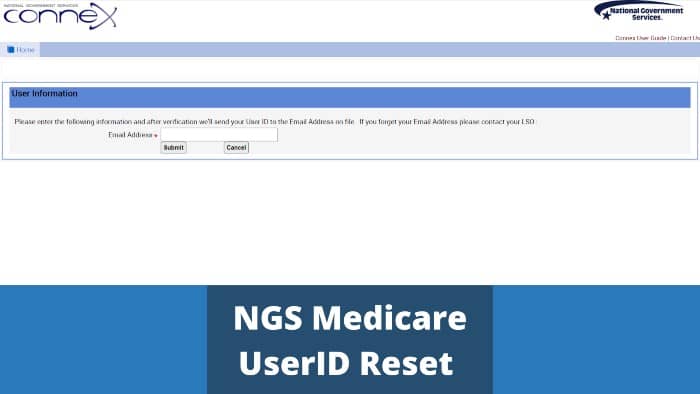
- Visit the official website of NGS Medicare at: https://www.ngsmedicare.com/. by visiting the valid browser.
- Go to the login page by clicking on the Login link.
- Click on the “Can’t log in” link.
- Select the “Reset username” link and enter your Email ID to receive the link to get the username in your email.
Password Reset
To reset the Password at NGS Medicare, you must follow the following steps:
- Visit the official website of NGS Medicare at: https://www.ngsmedicare.com/. by visiting the good browser.
- Click on the Login button.
- Click on the “Can’t log in” link.
- Select the “Reset password” link and enter your User ID and Email ID to receive the link to reset the forgotten password.
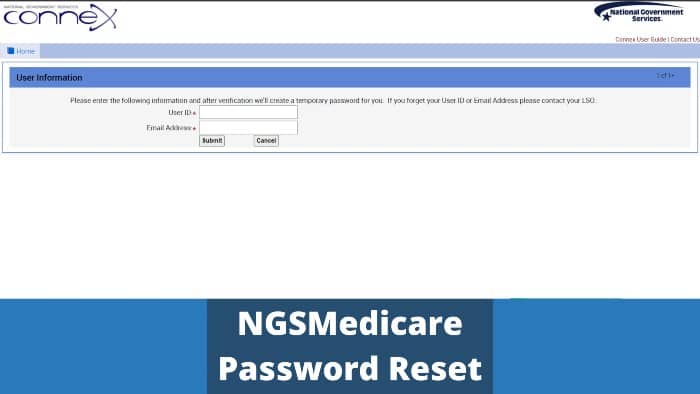
Contact Information
Toll-Free Number: 888-855-4356 / 877-702-0990, Monday–Friday: 8:00 a.m.–4:00 p.m. ET, It is closed for training on the 2nd and 4th Friday of the month from 12:00 to 4:00 pm ET.